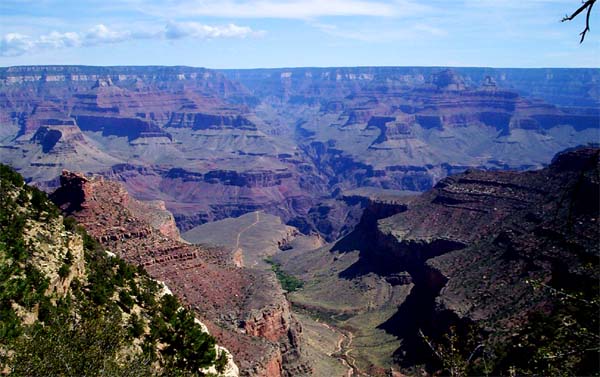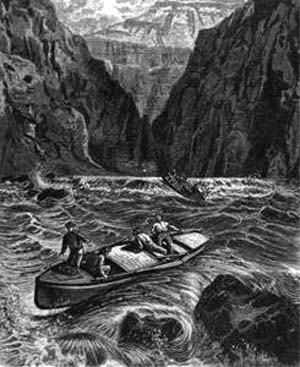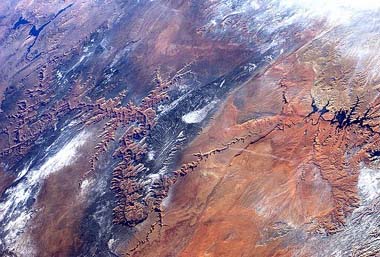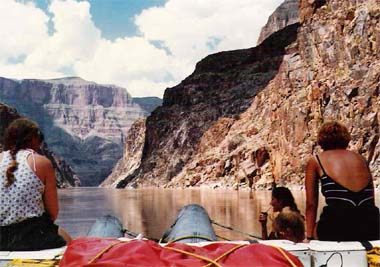 |
The
Grand Canyon
|

The
Grand Canyon is one of the most remarkable natural wonders in
the world. Located in the state of Arizona, USA, it is one of
the deepest gorges on Earth with an average depth of one mile
(1.6km) and an average width of ten miles (16km). The canyon
was carved over the past 6 million years by the action of the
Colorado River as it drops over 2,200 feet (670m) along the
277-mile (446 km) length of the gorge.
|
Seven
Quick Facts
|
| Average
Depth: 1 mile (1.6km) |
| Length:
277 miles (446km) |
| Average
Width: 10 miles (16km) |
| Discovered:
The ancient Anasazi people moved into the area around
1200 BC. The first European visited the canyon in 1540 A.D.. |
| Location:
Arizona, USA |
| Formed
By: The Colorado River as it cut through the Colorado
Plateau. |
| Other:
About 5 million people visit the Canyon each year.
|
The
canyon isn't just a single gorge, however, but also includes
numerous side canyons created by erosion. Because many layers
of rock were exposed during this process, the walls of the canyon
are countless shades of brown, yellow, red and gray. As the
sun moves across the sky the light changes making the vista
transform dramatically over the course of the day. The rock
levels represent a cross-section of the geological history of
the earth with the stone near the river being some of the oldest
on the planet with an age of nearly two billion years.
Formation
The
Colorado Plateau, through which the canyon is cut, was once
the bottom of a shallow sea. Along the rim visitors can still
find fossilized snails, corals and shell fish. Around 20 million
years ago the land was pushed upwards and the sea retreated.
Around six million years ago the Colorado River changed its
course and started cutting its way across the Plateau. The uplift
also added new tributaries to the river, increasing the river's
flow and adding many of the side canyons. Water let loose from
the glaciers of the ice ages also increased the amount of water
that was moving down the river and giving it more power to erode
the stone. Within two million years the river had sliced a path
into the rock that was only 500 feet higher than the bottom
of the canyon is today.
|

The
Powell expedition runs a set of rapids in 1869.
|
History
The
first European that saw the Grand Canyon was García López de
Cárdenas from Spain, who visited the location in 1540 during
a search for the fabled Seven "Gold" Cities of Cibola. However,
Native Americans had already been familiar with the canyon for
thousands of years. The ancient Anasazi people are the first
thought to inhabit the area starting about 1200 B.C.. For the
last 800 years or so the Havasupai people have lived in a part
of the gorge known as Cataract Canyon.
In 1869
John Wesley Powell led the first known boat expedition down
the Colorado River and through the canyon. Starting from Green
River, Wyoming on May 24, Powell and nine men in four wooden
boats with food for 10 months traveled down the Green River
to where it joined the Colorado. The group then crossed through
Glen Canyon and into the Grand Canyon where the boats had to
navigate more than 200 rapids. The trip became so difficult
that one man quit the expedition after the first month, and
another three left the group at Separation Canyon two months
later. The three attempted to climb out of the canyon but were
never heard from again. Powell finished his journey on August
13, 1869. Two years later Powell would retrace the voyage, this
time taking photographs and making detailed, accurate maps.
|

The
Grand Canyon as seen from orbit (NASA)
|
Tourism
By the
beginning of the 20th century the canyon, made famous by the
accounts of various scientists, explorers and the paintings
of artist Thomas Moran, had become a tourist attraction. In
1903 U.S. President Theodore Roosevelt visited the Grand Canyon.
Roosevelt, seeing its unique value, established the Grand Canyon
Game Preserve in 1906. He then designated the preserve a U.S.
National Monument in 1908. Roosevelt would have liked to have
made the canyon into a National Park, but opponents with interests
in land and mining rights blocked the effort for 11 years.
In 1919
the canyon was finally made a national park by an act of Congress.
It currently receives about five million visitors per year.
While many tourists limit themselves to looking at the canyon
from the rim, others chose to hike trails down into the gorge.
A trip to the bottom and back generally takes two days. For
those not inclined to hike, mules are available to ride to the
bottom. Located near the Colorado River in the deepest part
of the gorge is the Phantom Ranch which provides visitors with
lodging.
|

Modern
visitors raft down the Grand Canyon using rubber rafts.
The Canyon's rim is rarely visible from a boat on the
river. (Copyright Lee Krystek, 2011).
|
Another
way to explore the Canyon is by rafting down it following the
path first used by John Wesley Powell. Modern rafts, however,
are made of flexible rubber instead of wood, making the trip
safer, but still exciting.
Of the
two main rims of the canyon, the southern rim, is more accessible
and popular with visitors. There are a number of lodges located
on the South rim at Grand Canyon Village operated under contract
with the park service. The average altitude of the South rim
is about 7,000 feet (2133m) above sea level which can be a concern
for people who are not acclimated to that height. The North
rim is less accessible than the South and has fewer facilities
for visitors. It is also another 1000 feet higher in altitude
than the South rim.
Because
of its size and splendor, the canyon is a matchless natural
wonder. For this reason it is often considered as one of the
Seven Wonders of the Natural World.

Copyright
2011 Lee Krystek. All Rights Reserved.